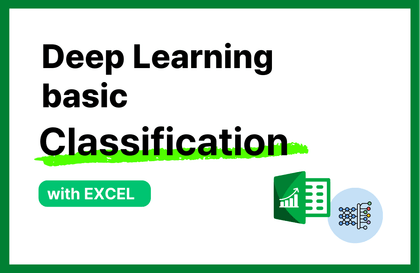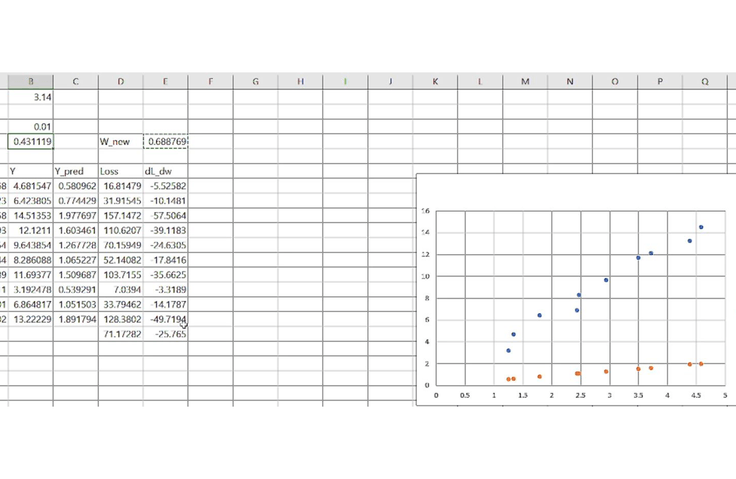
Deep Learning with Excel - Classification
hjk1000
Implement Deep Learning Basics in Excel for Deeper Understanding!
초급
Excel, VBA, Deep Learning(DL)
Let's visually learn the principles of deep learning using Excel.


Deep Learning Basics
Excel Usage
Let's learn the basics of deep learning using Excel.
Deep learning, a core component of artificial intelligence technology, is a model capable of autonomously learning and predicting patterns within complex data. However, this powerful technology ultimately operates through mathematical calculations and iterative optimization processes. Experiencing this process through hands-on experience provides a much deeper understanding than simply learning the theory. Excel, one of our most familiar tools, allows us to visually represent and directly manipulate formulas and data, making it an ideal tool for experiencing the deep learning learning process.
The purpose of this lesson is to implement directly in Excel how a deep learning model processes input data, calculates the difference between the predicted result and the actual value, and then adjusts the parameters to reduce this error. To do this, we will first start with the simplest form of deep learning model, the linear regression model. For example, the output value yyy follows the formula y=wx+by = wx + by=wx+b for the input value xxx, or y=w1x1+w2x2+by = w_1x_1 + w_2x_2 + by=w1x1+w2x2+b in multivariate expansion. The difference between the value predicted by this model and the actual value is measured through the 'loss function', and the model's parameters www and bbb are adjusted in a way that minimizes this loss.
This parameter adjustment utilizes an optimization algorithm called "gradient descent." Gradient descent works by calculating the gradient of the loss function and gradually adjusting the parameters based on that gradient. Mathematically, this process involves differentiation and matrix operations, and in deep learning, the "backpropagation" algorithm, which automatically handles this process, is at the core.
In Excel, each step (input, weight multiplication, output calculation, loss calculation, gradient calculation, parameter update) can be configured cell by cell. For example, input values and weights can be entered into separate cells, then multiplied to obtain a predicted value. The loss can then be calculated as the difference between the predicted value and the actual value. The gradient can then be calculated based on the loss, and the weights can be adjusted based on this, allowing the model to be gradually optimized.
Furthermore, by directly structuring these processes using Excel formulas, you can implement the core logic of deep learning by hand, without the need for frameworks like Python's TensorFlow or PyTorch. This goes beyond simple implementation; it greatly contributes to a deeper understanding of the internal structure and operating principles of deep learning.
In conclusion, we will utilize the familiar tool of Excel to directly implement and visualize core elements of deep learning, including basic concepts, learning structures, loss functions, gradient descent, and backpropagation. This will allow us to go beyond theoretical understanding and gain practical insights and intuition. Let's work through this process step by step and develop a fundamental understanding of deep learning together. Now, let's fully enter the world of deep learning!
Who is this course right for?
Those new to deep learning and curious about its principles
Anyone interested in implementing Deep Learning basics using Excel
1,520
Learners
41
Reviews
10
Answers
4.7
Rating
10
Courses
안녕하세요
비전공자로 딥러닝을 열심히 공부하는 직장인입니다.
공부하면서 느낀 점들을 여러분들과 함께 공유하고 싶습니다
감사합니다.
All
10 lectures ∙ (1hr 25min)
1. Deep learning
03:32
2. Data Preparation
09:01
3. Loss Definition
04:14
4. Gradient Descent
10:00
5. Preparing Data
12:34
7. GD issues
08:22
All
17 reviews
4.8
17 reviews
Reviews 2
∙
Average Rating 5.0
Reviews 3
∙
Average Rating 5.0
Reviews 1
∙
Average Rating 5.0
Reviews 66
∙
Average Rating 5.0
5
Thank you so much for the course review! I hope it helps you understand the basics of deep learning
$4.40
Check out other courses by the instructor!
Explore other courses in the same field!